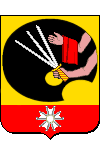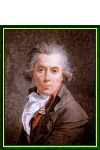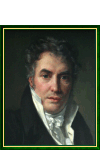First Painter of the Empire, Commander of the Légion d'Honneur
Pronunciation:

Jacques-Louis David was born in Paris on August 20, 1748 into a middle-class family. After his father died when he was nine years old, he was raised by an uncle on his mother's side. Recognizing the child's gift for drawing, he intended David to become an architect like two of his other uncles.
However, after having attended the Saint-Luc Academy to learn drawing, the young David presented himself to François Boucher as a pupil in 1764. Boucher was a distant relative on his mother's side and First painter to the King. Boucher thought him too old and sick and suggested he approach Joseph-Marie Vien. David joined Vien's atelier in 1766 and studied at the Royal Academy with Jean Bardin as he intended to compete for the Prix de Rome.
In 1771, he was awarded second place in the prestigious competition for The Combat of Minerva and Mars; he failed to win again in 1772 with Diana and Apollo Piercing Niobe's Children with Their Arrows and in 1773 with The Death of Seneca. These successive failures caused David to fall into a lengthy period of depression (he even attempted suicide) and soured his relationship with his academic institution. Finally in 1774, he won the Prix for Antiochus and Stratonice.
He left for Rome the following year with Vien. In Italy, he became very interested in the paintings of the Italian Renaissance. In Rome, he made hundreds of sketches of monuments, statues and ancient bas-reliefs and painted numerous canvasses in the style of Caravaggio. In Campania, he visited the ruins of Pompeii and Herculaneum. What he saw drastically altered his vision of art and informed his new style that was inspired by antiquity.
In 1780 at the Mancini palace, he presented Saint Roch Asking the Virgin Mary to Heal Victims of the Plague in Marseille which caused a sensation in Rome (and then in France in 1781). The same year, his work Belisarius (depicting the misfortune of Emperor Justinian's glorious general, who became a blind beggars after his fall from grace) confirmed David's conversion to the neoclassical style. During the following years, he painted the portrait of Count Stanislas Potocki, The Funeral of Patrocle and The Death of Méléagre.
After marrying Marguerite Charlotte Pécoul in 1782, he opened an atelier in the Louvre thanks to the generosity of his father-in-law. His first students were François-Xavier Fabre, Jean-Baptiste Wicar, Anne-Louis Girodet, Jean-Germain Drouais and Jean-Baptiste Debret. Around the same time, he was accepted as a member of the Academy in 1783 for Andromache Mourns Hector.
In 1785, he exhibited the Oath of the Horatii in Rome and then in Paris which definitively broke with Boucher's influence and was a huge public and critical success propelling David to the head of a new school of painting that would soon be called neoclassicism. In 1787, he painted Death of Socrates and the following year Paris and Helene (a commission from the Count of Artois, the future Charles X), Portrait of Antoine-Laurent Lavoisier and His Wife and The Lictors Bring to Brutus the Bodies of His Sons on the eve of the Revolution. This last work was a huge public success and is still known today as a minor revolution in painting.
During the revolutionary years, David continued to paint, but he also became heavily involved in politics, which was unusual for an artist. Starting in September 1789, he led a group of members of Academy who were demanding substantial institutional reform in the art world, an end to the privileges of the Academy and the right for unaccredited artists to display their work at the Salon. In 1790, he began what should have been his largest work at ten meters by seven meters: Le Serment du jeu de paume. A fund was started, but the necessary resources were unavailable and the work was never completed. The same year, he succeeded in ending the Royal Academy's monopoly over the Salon and urged the Assembly to dismantle all of the other Academies.
David signed a petition in 1791 calling for the removal of Louis XVI on the Champ de Mars. In 1792, his political positions began to become more radical. He was elected as a representative for Paris in the National Convention with the support of Jean-Paul Marat. He was named to the Committee for Public Instruction and as such was in charge of organizing civic and revolutionary holidays, the administration of the arts and ... propaganda. In January 1793 he voted for the death of the King. Following Marat's assassination on July 13, 1793, he was commissioned by the Convention to paint The Death of Marat, one of his most famous works and emblematic of his revolutionary period. He also organized his dead friend’s funeral.
Soon after, he painted The Death of Joseph Bara depicted the famous episode that would inspire revolutionary iconography for generations to come. Another drawing attributed to David is Marie-Antoinette on the Way to the Guillotine which is supposed to have been composed by the artist from the window of a neighbouring window as the event unfolded...
David held several important political positions: he was President of the Jacobin Club, Secretary and then President of the Convention, a member of the Committee of General Security and President of the sub-committee for interrogations.
During this dark period, David was know to have helped some (Dominique Vivant Denon, Jean-Honoré Fragonard, and Antoine-Jean Gros) and to have been complicit in the execution of many others (Fabre d'Églantine, Alexandre de Beauharnais, the Trudaine brothers, Lavoisier, the Duchess de Noailles, André Chénier, and Carle Vernet's sister). Even though David had publicly assured Robespierre of his support on 8 Thermidor Year II (July 26, 1794, in the French Republican Calendar), a opportune illness caused him to miss the Convention session the next day when L'Incorruptible (The Incorruptible) fell from power. David also escaped the fate of Robespierre and his compatriots. Even so, he was arrested and imprisoned until December 1794 when he was released due to the lack of substantiated charges against him.
He tried to avoid the public eye by spending time in Saint-Ouen, but he was imprisoned once again between May and October 1795 following new accusations. Eventually, he benefited from a political amnesty covering the Revolution
Under the Directory, David devoted himself to a substantial new work The Intervention of the Sabine Women which he began in 1795 and finished in 1798. The relevant theme (fratricidal rivalry, the virtue of concord), the new style (nudity) and the new form of exhibition (admission was charged) confirmed the work's ongoing success.
Near the end of 1797, David met Napoleon Bonaparte and offered to paint his portrait. This work, for which the young general agreed to only one sitting, went unfinished but is regarded as one of the best portraits of Bonaparte. In 1800, he painted three copies of Napoleon Crossing the Alps as requested by its subject, and a Portrait of Madame Récamier.
In October 1804, Napoleon commissioned four works from David to commemorate his coronation including The Coronation of Napoleon . As a result David was named First painter to the court. He spent three years painting The Coronation of Napoleon which became his largest work (9.8 meters by 6.2 meters). Interestingly, the moment during the ceremony (when Napoleon crowed Joséphine as Empress) was suggested to David by his former student François Gérard. In addition, the Emperor requested some modifications including the gesture of blessing from Pope Pius VII and the presence of Napoleon's mother at the ceremony. The Salon in 1808 was dominated by the exposition of Coronation. David was rewarded for his efforts when the Emperor made him an Officer of the Legion of Honour.
Around the same time, he painted The Distribution of the Eagle Standards (part of the same commission), Sappho and Phaon (1809) and continued work on Leonidas at Thermopylae (begun in 1800, he did not complete it until 1814). Around 1810 official commissions abruptly stopped. The difficulty of paying David was aggravated by his extremely high rates. As a result, the last portrait he painted of the Emperor, the celebrated Napoleon in His Study from 1812, was not an official commission but a private one from a Scottish nobleman.
Striped of his position as First painter during the first Restoration, he regained the title during the Hundred Days and was promoted to Commander of the Legion of Honour. After Waterloo, he sought refuge first in Switzerland, returned to France in August 1815, and left the country for good in January 1816 for Brussels. There he painted a number of portraits (including that of Charlotte and Zénaïde Bonaparte, the daughters of Joseph, in 1821) and several scenes from Greek myth: Cupid and Psyche (1817), The Anger of Achilles (1819), The Farewell of Telemachus and Eucharis (1818 to 1822) and Mars Being Disarmed by Venus and the Three Graces (1824).
Jacques-Louis David died in Brussels on December 29, 1825 following a stroke. He is buried in the Saint-Josse-ten Noode Cemetary, but his heart lies in Paris in the 56th division of the Père Lachaise Cemetary .
"Self-portrait" by Jacques-Louis David.

David is considered the foremost painter of the Neoclassical School for incarnating its pictorial style and intellectual leanings: My aim is to regenerate the arts by developing a style of painting that the ancient Greeks and Romans could have accepted as their own without hesitation
.
He was initially influenced by François Boucher's Rococo style, then by Raphael and the Caravaggists. David broke with the dominant style of the 18th century and instead embraced the classical heritage of Nicolas Poussin. He would continue to use the style he adopted in Belisarius and the Vow of the Horatii for the rest of his career with only slight variations.
He was the mentor of two generations of artists who came from all over Europe to work in his atelier that at its height had some 40 students (there were between 280 and 470 from 1780 to 1821). Among these were Girodet, Isabey, Gros, Gérard and Ingres.
The Postal Service of the Republic of France released an 8-franc stamp bearing the image of Jacques-Louis David in 1950.
Acknowledgements
Other portraits

Enlarge
"Self-portrait" by Jacques-Louis David.

Enlarge
"Jacques-Louis David" peint en 1817 by François-Joseph Navez (Charleroi 1787 - Brussels 1869).